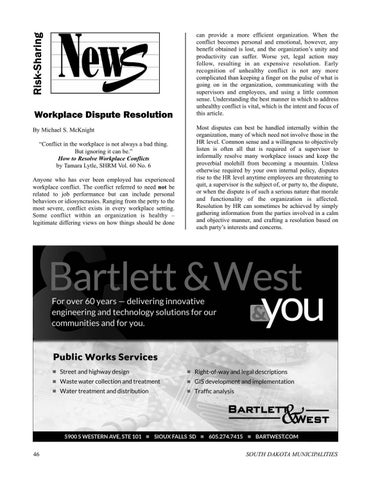Risk-Sharing Workplace Dispute Resolution By Michael S. McKnight “Conflict in the workplace is not always a bad thing. But ignoring it can be.” How to Resolve Workplace Conflicts by Tamara Lytle, SHRM Vol. 60 No. 6 Anyone who has ever been employed has experienced workplace conflict. The conflict referred to need not be related to job performance but can include personal behaviors or idiosyncrasies. Ranging from the petty to the most severe, conflict exists in every workplace setting. Some conflict within an organization is healthy – legitimate differing views on how things should be done
46
can provide a more efficient organization. When the conflict becomes personal and emotional, however, any benefit obtained is lost, and the organization’s unity and productivity can suffer. Worse yet, legal action may follow, resulting in an expensive resolution. Early recognition of unhealthy conflict is not any more complicated than keeping a finger on the pulse of what is going on in the organization, communicating with the supervisors and employees, and using a little common sense. Understanding the best manner in which to address unhealthy conflict is vital, which is the intent and focus of this article. Most disputes can best be handled internally within the organization, many of which need not involve those in the HR level. Common sense and a willingness to objectively listen is often all that is required of a supervisor to informally resolve many workplace issues and keep the proverbial molehill from becoming a mountain. Unless otherwise required by your own internal policy, disputes rise to the HR level anytime employees are threatening to quit, a supervisor is the subject of, or party to, the dispute, or when the dispute is of such a serious nature that morale and functionality of the organization is affected. Resolution by HR can sometimes be achieved by simply gathering information from the parties involved in a calm and objective manner, and crafting a resolution based on each party’s interests and concerns.
SOUTH DAKOTA MUNICIPALITIES






















